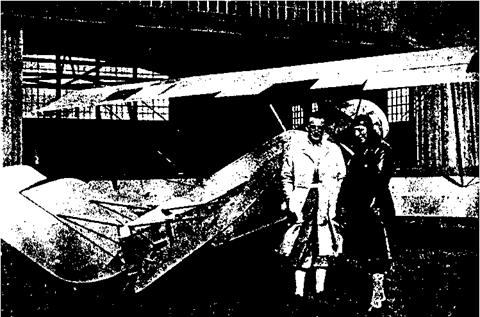Vee – or Butterfly Tails
A vee-tail or butterfly tail is a wing with a large amount of positive dihedral. If the vee-tail is built with negative dihedral, or anhedral, it is called an inverted vee-tail. Vee-tails or inverted vee-tails are used instead of the usual horizontal and vertical tails, replacing three surfaces with two. The Beech Model 35 Bonanza is the vee-tailed airplane most people have seen. Over 12,000 of them have been built. A very early vee-tail installation was made by Rudlicki in 1931 (Figure 14.10).
Why vee-tails? An evident advantage is that there is one fewer tail surface to build, assuming that horizontal tails are built in two halves. There is also less interference drag because there is one fewer tail-fuselage junction. Other possible advantages are dependent on the configuration. The inverted vee-tail of the General Atomics Gnat 750 protects the pusher propeller, serving as a bumper for tail-down landings (Figure 14.11).
Entire vee-tail surfaces, or flaps on their trailing edges, are deflected symmetrically for pitch control and asymmetrically, that is, with equal and opposite angles, for yaw control. There is a small rolling moment generated in the asymmetric case. For vee-tails with positive dihedral the rolling moment is adverse, in the following sense. Right rudder and yawing moment are generally applied by a pilot or autopilot during right rolls, to overcome adverse yaw. However, with a positive dihedral vee-tail, a left rolling moment is generated by the
|
Figure 14.10 Polish engineer Georges Rudlicki (on the left) with test pilot W. Szubczewski in front of the Hanriot 14 biplane fitted with Rudlicki’s V-tail design in 1932. This configuration was successfully tested by Szubczewski and two other pilots. (From Aircraft Engineering, March 1932) |
|
Figure 14.11 An inverted vee-tail airplane, the Amber, predecessor of the General Atomics Gnat 750 UAV (Unmanned Aerial Vehicle), used in 1994 forU. S. reconnaissance over Bosnia. (From Leading Systems, Inc.) |
right rudder deflection, opposing the ailerons. Of course, this effect is reversed for inverted vee-tails, favorable rolling moments accompanying rudder deflection in rolls.
Negative tail dihedral plays an important role in avoiding pitchup for swept-wing airplanes at high subsonic Mach numbers. Though strictly not inverted vee-tails, negative tail dihedral is found on such airplanes as the McDonnell Douglas F-4 Phantom and the Dassault/Breguet/Dornier Alpha Jet.
Vee-tail surface stalling has been a continuing stability and control concern. A dangerous, abrupt pitch-down due to tail stall during landing approaches is possible. This could happen at forward center of gravity positions, with landing flaps full down, requiring down tail load for trim. If at the same time the landing approach is being made in rough air, appreciable sideslip angles can develop while the pilot fights the Dutch roll mode of motion. The combination of large down load and sideslip excursions could bring momentarily one vee – tail panel beyond its stall, relieving part of the down load and causing an abrupt diving moment.
Professor Ronald O. Stearman has looked into vee-tail stalling in sideslips at forward centers of gravity as a possible cause of the relatively high accident rate of the vee-tailed Beech Model 35. The Model 35’s accident rate is seven times as high as the Beech Model
33, which is essentially the same airplane equipped with a conventional tail. Stearman’s (1986) tests show that a vee-tail panel would stall, causing the Model 35 to nose over at a sideslip angle of 10 to 12 degrees. Flight tests conducted for Beech failed to reproduce Stearman’s results. Vee-tail stalling remains a potential problem, which is an argument for making vee-tails somewhat oversized. Oversized tail surfaces would decrease the panel angles of attack required to produce given tail loads.
Estimation of required vee-tail size and dihedral angles was dealt with definitively by Paul E. Purser and John P. Campbell (1945). A naive approach to the problem would merely take the vee-tail’s projected areas in plan and side views as effective horizontal and vertical areas, respectively. However, the Purser-Campbell method deals with the actual panel loads, considers interference between the vee-tail panels, and works out the trigonometry for panel angle of attack and force resolution. Purser and Campbell provide convincing experimental verification of their vee-tail theory, using wind-tunnel test data (Figure 14.12).













